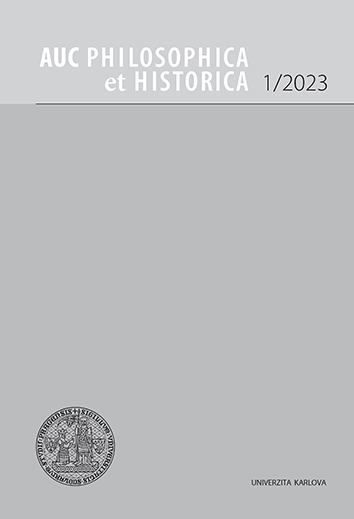AUC Philosophica et Historica je víceoborový akademický časopis zaměřený na humanitní a společenskovědné obory (filozofie, psychologie, pedagogika, sociologie, obecné, české a hospodářské dějiny, pomocné vědy historické a archivnictví, etnologie).
Časopis je indexován v databázích CEEOL, DOAJ a EBSCO.
AUC PHILOSOPHICA ET HISTORICA, Vol 2021 No 1 (2021), 231–249
„Děti, děti, z toho kouká buď blázinec, nebo vězení!“ Vídeňský akcionismus jako reakce na válečné, osobní i společenské trauma
[“Kids, kids, it’s either madhouse or jail!” Viennese Actionism as a response to wartime, personal and social trauma]
Tomáš Kubart
DOI: https://doi.org/10.14712/24647055.2023.12
zveřejněno: 23. 06. 2023
Abstract
A group of “Viennese Actionists” was formed in Austria around 1961, ceasing to be active in 1970. One decade of their collaboration comprised creation of a series of multimedia artistic works, often in the form of provocative actions using the so-called Schweinvocabular (“nasty vocabulary”): fake violence, vulgarity, explicit sexuality, profaning state and church symbols, etc. The aim of such aesthetics was not a dull provocation; it was rather an artistic means by which the first generation of post-war artists, who personally experienced the horrors of World War II and the reverberations of the first, responded to the lack of denazification and the internal conflicts in the Austrian society. The paper will present the thesis that the designation of the group as “Viennese Actionism” is probably not derived from the noun “action”, but it is a reference to the current in behavioral psychology called sensomotoric actionism, which originated in the early 20th century and emphasized physical and performative coping with the trauma the Actionists experienced in young age (pain, suffering, loss of loved ones, mass scale of murders, etc.); sensomotoric actionism as a metaphor of artistic response to social trauma. One of the main impulses for the Actionists was thus the war trauma, both on an individual and socio-cultural level. The aesthetic means they employed were based on the actual contemporary methods of treating trauma. Using repulsive “images” that presented the horrors of war, the Actionists “forced” their audience to confront them and, if possible, go through social catharsis, giving back to the theater its ritual function it had in the society of the Classical Athenian polis.
klíčová slova: Viennese Actionism; posttraumatic stress disorder; PTSD; Wiederholungstrauma; neurosis; psychoanalysis and art; collective trauma; performativity; cultural naratives; war victim; Schweinvokabular; Totschweigen; Schmerzensmänner; The mans of sorrow; Le Bouc émissaire; the Scapegoat
reference (26)
1. Richard Müller-Freienfels, Psychologie přítomnosti. Praha 1937 CrossRef
2. Hilde Spiel, Aus der Tiefe der Zeit. Abwege der Wiener Avantgarde, Frankfurter Allgemeine Zeitung. 30. 4. 1964, s. 32
3. Otto Muehl, Mama & Papa. Materialaktion 63-69, Frankfurt 1969
4. Robert Hughes, "The Decline and Fall of the Avant-Garde", Time XVIII., 1972
5. Die Schastrommel, 1972, 8b.
6. Verena Auffermann, Eros im Lazarett, Frankfurter Rundschau XXXIX, č. 192, 16. 8. 1984, s. 8
7. Georg Schmid, Konterstrategien zum Totschweigen. Wie sich die Ekritüre dem Erstricktwerden widersetzt, in: Walter Buchebner Gesselschaft, Die Wiener Gruppe, Wien 1987
8. Carl Gustav Jung, Výbor z díla I. Základní otázky analytické psychologie a psychoterapie v praxi, Brno 1996
9. Carl Gustav Jung, Výbor z díla III. Osobnost a přenos. Brno 1998
10. Hermann Nitsch, Das Orgien Mysterien Theater. Das 6 Tage Spiel, Wien 1998
11. Viktor E. Frankl, Teorie a terapie neuróz: Úvod do logoterapie a existenciální analýzy, Praha 1999
12. Hella Pick, Guilty Victim. Austria from the Holocaust to Haider, London 2000
13. Michaela Huber, Trauma und die Folgen. Trauma und Traumabehandlung. Teil 1, Paderborn 2003
14. Yvonne Ziegler, Rudolf Schwarzkogler: Darstellungen von Gewalt und Anleitungen zur Heilung in Aktion, Fotografie, Zeichnung und Text. Band 3, nepublikovaná dizertace Fakultät der Albert- Ludwigs-Universität Freiburg, Freiburg 2004
15. Stanislav Balík, Dollfuß a Schuschniggovo Rakousko, Vídeňské svobodné listy LXIII, 2007, č. 7/8, s. 5-7
16. Freya Martin, Das Phänomen Hermann Nitsch und sein Orgien Mysterien Theater im kontext der Antiken Griechischen Tragödie, nepublikovaná dizertace Institutu für Theater-, Film- und Medienwissenschaft UniVie, Wien 2007
17. Oswald Panagl - Peter Gerlich (eds), Wörterbuch der politischen Sprache in Österreich, Wien 2007
18. Hermann Nitsch, Das Orgien Mysterien Theater. Kostümentwürfe, Reliktbilder, Aktionsmalerei und Video, Zürich 2008
19. Richard Noll, Encyclopedia of Schizophrenia and Other Psychotic Disorders, New York, 2009
20. Gerald Schröder, Schmerzensmänner. Trauma und Therapie in der westdeutschen und österreichischen Kunst der 1960er Jahre, München 2011 CrossRef
21. Felicia Englmann, 1965: das Jahr, in dem Träume wahr wurden, München 2014
22. Stefan Karner - Alexander O. Tschubarjan (eds), Die Moskauer Deklaration 1943: "Österreich wieder herstellen", Wien 2015 CrossRef
23. Günter Bischof, Rakousko v první studené válce, 1945-1955: I slabí mají sílu, Praha 2017
24. Ota Konrád - Rudolf Kučera, Cesty z apokalypsy. Fyzické násilí v pádu a obnově střední Evropy 1914-1922, Praha 2018
25. Klaus Theweleit, Männerphantasien, Berlin 2019
26. Plötzlich "Wasserkopf". Wiener Zeitung, https://www.wienerzeitung.at/nachrichten/chronik/wien/1000468-Ploetzlich-Wasserkopf.html?em_cnt_page=3, vyhledáno 12. 1. 2021

„Děti, děti, z toho kouká buď blázinec, nebo vězení!“ Vídeňský akcionismus jako reakce na válečné, osobní i společenské trauma is licensed under a Creative Commons Attribution 4.0 International License.
